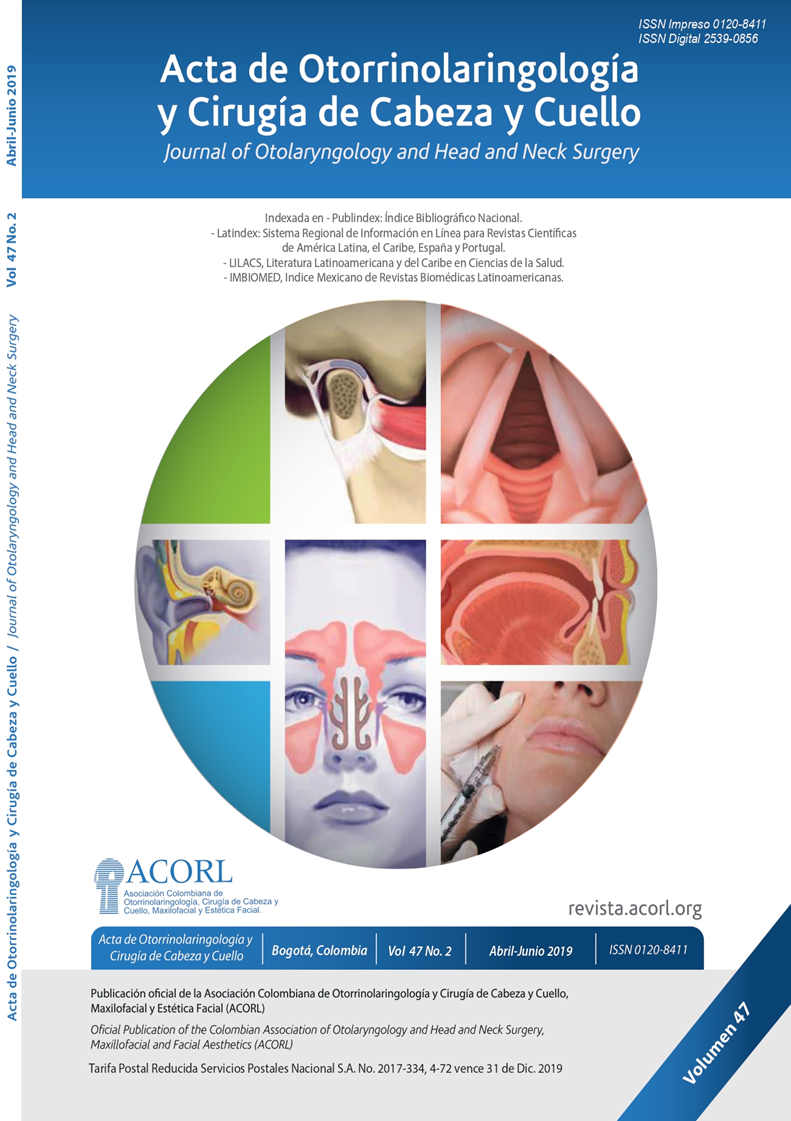Resultados postoperatorios de cierre quirúrgico de perforación septal con injertos de cartílago.
Contenido principal del artículo
Resumen
Introduccio?n: Las perforaciones septales y su correccio?n quiru?rgica constituyen un reto para los otorrinolaringo?logos. Se encuentran descritas en la literatura diferentes te?cnicas para el cierre de perforaciones septales; sin embargo, sus resultados en te?rminos de efectividad son muy variables y con pocos pacientes. Desde hace 8 an?os se viene realizando la te?cnica de cierre de perforacio?n septal con injertos de carti?lago en el servicio de otorrinolaringologi?a del Hospital San Jose? y se ha observado una respuesta cli?nica exitosa.
Objetivo: describir los resultados postoperatorios de los pacientes manejados con la te?cnica de cierre quiru?rgico de perforacio?n septal con injertos de carti?lago, en te?rminos de aparicio?n de complicaciones y frecuencia de perforacio?n septal residual. Disen?o: estudio de tipo cohorte descriptiva.
Metodologi?a: se describe una cohorte de pacientes manejados con la te?cnica de cierre quiru?rgico de perforacio?n septal con injertos de carti?lago de banco o carti?lago auto?logo. Se incluyeron pacientes a partir de enero de 2014 a junio de 2018. Se extrajeron de la historia cli?nica los datos demogra? cos, cli?nicos, complicaciones y presentacio?n de perforacio?n septal residual.
Resultados: la tasa de e?xito de cierre de perforacio?n septal fue de 78,3 %; siendo las etiologi?as ma?s frecuentes antecedente de cirugi?a e idiopa?tica. La complicacio?n ma?s comu?n fue epistaxis en el 26 % de los pacientes, seguida de dolor en el 21,7 % en el postoperatorio mediato, el cual mejoro? en los controles posteriores. Conclusio?n: Los resultados con la te?cnica de cierre de perforacio?n septal con injerto de banco fueron satisfactorios en esta poblacio?n.
Detalles del artículo
Sección

Esta obra está bajo una licencia internacional Creative Commons Atribución-CompartirIgual 4.0.
Este artículo es publicado por la Revista Acta de Otorrinolaringología & Cirugía de Cabeza y Cuello.
Este es un artículo de acceso abierto, distribuido bajo los términos de la LicenciaCreativeCommons Atribución-CompartirIgual 4.0 Internacional.( http://creativecommons.org/licenses/by-sa/4.0/), que permite el uso no comercial, distribución y reproducción en cualquier medio, siempre que la obra original sea debidamente citada.
eISSN: 2539-0856
ISSN: 0120-8411
Cómo citar
Referencias
Oberg D, Akerlund A, Johansson L, Bende M. Prevalence of nasal septal perforation: the Skövde population-based study. Rhinology. 2003;41(2):72-5.
Diamantopoulos II, Jones NS. The investigation of nasal septal perforations and ulcers. J Laryngol Otol. 2001;115(7):541-4.
Taylor RJ, Sherris DA. Prosthetics for nasal perforations: a systematic review and meta-analysis. Otolaryngol Head Neck Surg. 2015;152(5):803-10.
Kim SW, Rhee CS. Nasal septal perforation repair: predictive factors and systematic review of the literature. Curr Opin Otolaryngol Head Neck Surg. 2012;20(1):58-65.
Wong S, Raghavan U. Outcome of surgical closure of nasal septal perforation. J Laryngol Otol. 2010;124(8):868-74.
Watson D, Barkdull G. Surgical management of the septal perforation. Otolaryngol Clin North Am. 2009;42(3):483-93.
Bast F, Heimer A, Schrom T. Surgical closure of nasoseptal defects: postoperative patient satisfaction. ORL J Otorhinolaryngol Relat Spec. 2012;74(6):299-303.
Moon IJ, Kim SW, Han DH, Kim ST, Min YG, Lee CH, et al. Predictive factors for the outcome of nasal septal perforation repair. Auris Nasus Larynx. 2011;38(1):52-7.
Kridel RW. Considerations in the etiology, treatment, and repair of septal perforations. Facial Plast Surg Clin North Am. 2004;12(4):435-50, vi.
Schultz-Coulon HJ. Three-layer repair of nasoseptal defects. Otolaryngol Head Neck Surg. 2005;132(2):213-8.
Dosen LK, Haye R. Surgical closure of nasal septal perforation. Early and long term observations. Rhinology. 2011;49(4):486-91.
Romo T, Foster CA, Korovin GS, Sachs ME. Repair of nasal septal perforation utilizing the midface degloving technique. Arch Otolaryngol Head Neck Surg. 1988;114(7):739-42.
Murakami CS, Kriet JD, Ierokomos AP. Nasal reconstruction using the inferior turbinate mucosal flap. Arch Facial Plast Surg. 1999;1(2):97-100.
Bank J, Beederman M, Naclerio RM, Gottlieb LJ. Prelaminated fascia lata free flap for large nasal septal defect reconstruction. J Plast Reconstr Aesthet Surg. 2014;67(10):1440-3.
Pereira C, Santamaría A, Langdon C, López-Chacón M, Hernández-Rodríguez J, Alobid I. Nasoseptal Perforation: from Etiology to Treatment. Curr Allergy Asthma Rep. 2018;18(1):5.
Hong SN, Mutsumay S, Jin HR. Long-term Results of Combined Rhinoplasty and Septal Perforation Repair. JAMA Facial Plast Surg. 2016;18(6):475-80.
Delaney SW, Kridel RWH. Contemporary Trends in the Surgical Management of Nasal Septal Perforations: A Community Survey. Facial Plast Surg. 2019;35(1):78-84.
Newton JR, White PS, Lee MS. Nasal septal perforation repair using open septoplasty and unilateral bipedicled flaps. J Laryngol Otol. 2003;117(1):52-5.
Raol N, Olson K. A novel technique to repair moderate-sized nasoseptal perforations. Arch Otolaryngol Head Neck Surg. 2012;138(8):714-6.
Kaya E, Cingi C, Olgun Y, Soken H, Pinarbasli Ö. Three layer interlocking: a novel technique for repairing a nasal septum perforation. Ann Otol Rhinol Laryngol. 2015;124(3):212-5.
Sapmaz E, Toplu Y, Somuk BT. A new classification for septal perforation and effects of treatment methods on quality of life. Braz J Otorhinolaryngol. 2018.
Kridel RWH, Delaney SW. Discussion: Acellular Human Dermal Allograft as a Graft for Nasal Septal Perforation Reconstruction. Plast Reconstr Surg. 2018;141(6):1525-7.





